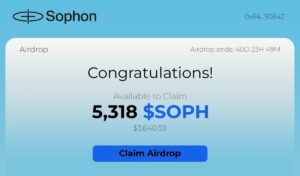Key Takeaways
- Sophon leverages modular architecture and ZKsync to offer scalable, low-cost, high-speed infrastructure for decentralized apps.
- Key innovations like Data Availability Sampling (DAS) and Namespace Merkle Trees (NMT) reduce network load and improve data handling.
- The ecosystem is expanding rapidly, with RaaS platforms and deep integrations into Arbitrum and Cosmos.
- Real-world use cases include DeFi, ZKML, gaming, and RWA tokenization—positioning Sophon as more than just a technical upgrade.
- The $SOPH token airdrop is live, and full token tradability begins in Q1 2025.
Sophon, a modular blockchain built on ZKsync, is gaining momentum for its innovative architecture and developer-centric design. Sophon is attracting infrastructure builders, investors, and Web3 startups by decoupling core blockchain layers and optimizing data availability. This Market Insights article explores Sophon’s architecture, ecosystem growth, real-world applications, and potential market impact ahead of its Q1 2025 token launch.
Technical Architecture: Revolutionary Modular Design
Sophon, a modular blockchain built on ZKsync, achieves unprecedented flexibility and efficiency by decoupling traditional blockchain layers: consensus, execution, settlement, and data availability (DA). Its core innovations include Data Availability Sampling (DAS: Allows light nodes to verify data integrity through random sampling) and Namespace Merkle Tree (NMT: Organizes block data into application-specific namespaces, enabling Rollups to process only relevant data and reducing network load) technologies. This design slashes deployment costs for developers. For example, projects like Manta Network have rapidly built ZK applications on Sophon, while integration with Arbitrum Orbit expands its Ethereum ecosystem influence. For users, this translates to lower fees and faster confirmations, especially on platforms supporting Sophon-based token transactions.

Ecosystem Potential: From Infrastructure To Application Boom
Sophon’s ecosystem growth shows three trends:
- RaaS (Rollup-as-a-Service) Platforms Rise: Movement Labs, ZKFair, and others deploy customized chains via Sophon’s modular framework, attracting developers from monolithic chains.
- Enhanced Cross-Chain Interoperability: Deep integration with Arbitrum and Cosmos positions Sophon as a multi-chain hub. Models like Dymension’s DYM airdrop to Celestia communities could be replicated.
- Institutional Capital Inflow: Investments from Binance Labs, OKX Ventures, and others provide long-term resource support.
Real-World Use Cases & Adoption Pathways
As modular blockchains become foundational to the next generation of Web3 infrastructure, Sophon’s architecture is already enabling real-world innovations across multiple sectors:
- DeFi Protocol Scaling: Projects are leveraging Sophon’s low-latency settlement layer and data availability optimization to launch decentralized exchanges (DEXs) and lending platforms that can handle thousands of transactions per second—without sacrificing security or decentralization.
- ZKML and Private AI Integration: The combination of ZKsync and modular architecture supports privacy-preserving AI models. Startups building ZKML solutions can offload compute-intensive operations onto Sophon-based rollups with verifiable outputs.
- GameFi and High-Frequency dApps: Sophon’s fast confirmation times and namespace structure are ideal for real-time games and metaverse apps that require microtransactions and dynamic user interaction.
- Enterprise and RWA (Real World Asset) Tokenization: Sophon’s modular layers allow institutions to deploy permissioned chains or subnets with fine-grained access control, paving the way for tokenized real estate, commodities, and intellectual property.
By illustrating these practical implementations, the Sophon ecosystem moves from an abstract infrastructure play to a driver of tangible innovation across the blockchain landscape.
Sophon Airdrop Participation Guide
Starting January 1, 2025, Sophon node holders will accumulate rewards, with the SOPH token becoming fully tradable in Q1. Current airdrop pathways include:
- Mainnet Node Staking: Deploy nodes and stake tokens via Sophon’s official site for early contributor rewards. Note: Tokens are non-transferable until permissions open.
- Ecosystem Interactions: Engage with testnet DApps and cross-chain bridges. Projects like Movement Labs have confirmed airdrops to Sophon communities.
- Exchange Campaigns: Monitor JuCoin Announcements for potential holding rewards or trading mining events.
Market Opportunities & Challenges
Opportunities:
- ZK proofs + modular architecture create high technical barriers, with vast potential in privacy computing and compliance scenarios.
Risks:
- Technical Complexity: Balancing customization and interoperability; untested cross-chain protocols at scale.
- Token Liquidity Risk: SOPH’s full transferability delayed to Q1 2025 may trigger volatility.
- Competition: Rivals like Celestia and Avail hold market share; differentiation is critical.
Investors should track on-chain metrics (e.g., node staking rates) and regulations while capitalizing on the modular ecosystem’s growth phase.






